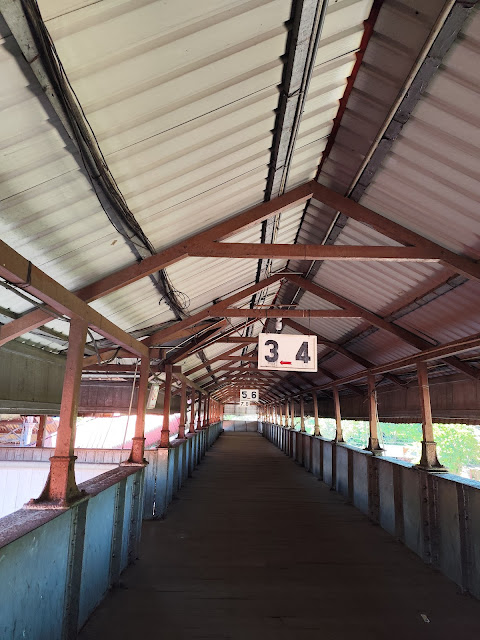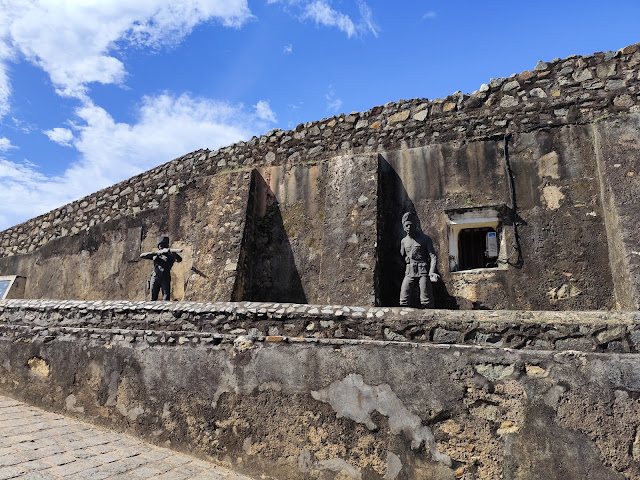 |
Fort Railway Station (1908)
Colombo, Sri Lanka |
 |
Scenic Ocean View - Beautiful Train Ride
Colombo > Galle (130km) |
 |
Galle Fort (UNESCO)
Sri Lanka |
Day 3 Saturday Nov 16 2024 (Day 2 Colombo, Sri Lanka) - my Saturday Feverish train ride from Fort Railway Station > Galle Railway Station (130km, about 2 hours), scenic ocean view along the shoreline & a visit to the Galle Fort, a UNESCO World Heritage Site; a down the memory lane visit for me as my last visit to Galle Fort was in Jan 2013 by bus (to & return) from Colombo > Galle, an arduous & long bus ride (4 hours one way due to congested roads) ! Also visited Kandy & Sigiriya in Jan 2013, those were the Good Old Days !
Sri Lanka & Malaysia are like a Siamese twins - both have quite a similar colonial history (under Portuguese, Dutch & British rules). Sri Lanka was under Portuguese influence in 1505 > 1658, followed by Dutch in 1658 >1796 and then British in 1796 > 1948. Sri Lanka was declared independence in 1948. Whereas Melaka or now Malacca (a state of Malaya) was under Portuguese rule in 1511 > 1641 & the Dutch in 1641 > 1798; Malaya was under British administration in 1826 > 1942, Japanese occupation in 1942 > 1945; Malaya (now Malaysia) achieved her independence from the British in 1957.
 |
| Sri Lanka Map |
 |
| Malaya Map |
1) Hotel Accommodation: my 4 nights stay in Saveira Colombo Hotel, Havelock Road, Colombo, Sri Lanka; room tariff Rm67 (US$15.20) twin sharing.
2) Bus ride from our hotel to Fort Railway Station & the surrounding, Colombo, Sri Lanka.
3) Pettah Market, Keyzer Street, Colombo, Sri Lanka - a bustling local market selling a wide varieties of A to Z items including fresh fruit & food.
4) Fort Railway Station (1908), Colombo, Sri Lanka - built & in operation in 1908, a major rail hub in Colombo, the station is served by Sri Lanka Railways with many inter-city & commuter trains entering each day, Fort Station is the main rail gateway to central Colombo, it is the terminus of most intercity trains in the country.
5) Fort Railway Station (Interior), Colombo, Sri Lanka - an old style railway station with 10 platforms, high ceilings, overhead passenger transit platforms, a separate toilet for foreigners, matrix signs with departure information, small vendors selling finger food, bread & pastries, bottled water & drink, benches for passengers sitting etc
6) Washroom / Toilet, Fort Railway Station, Colombo, Sri Lanka
7) Daily train arrivals & departures, Fort Railway Station, Colombo, Sri Lanka
8) Railway Canteen, Fort Railway Station, Colombo, Sri Lanka
9) Old Photos of Fort Railway Station, Colombo, Sri Lanka
10) The start of my train ride from Fort Railway Station > Galle Railway Station - approx 2hrs 15 minutes, free seating but train was packed due to the Saturday weekend, be prepared to stand throughout the journey if no vacant seats are available !
11) Cityscape of Colombo as viewed from a moving train's windows





12) Ocean & offshore views of train ride (running parallel to the shoreline) from the south of Galle Face Green, Colombo > Galle, spectacular coastal scenery, deep blue sea, coastal villages, rows of coconut trees, chalets & holiday homestay, sandy beaches, ocean waves, suspension bridges, brief stopovers in train stations, I stood for almost an hour near to an exit door hence was able to take a number of pictures on the shoreline & ocean views (a blessing in disguise) !
13) Arriving in Galle Railway Station - my first & a memorable train journey in Sri Lanka !
14) Galle Railway Station, Sri Lanka - a railway station in the southern city of Galle, a state-owned Sri Lanka Railways, the station is part of the Coast Line which links south coast with the Colombo.
15) Downtown Galle, Galle Bus Station & Commercial area, nearby to Galle Railway Station.
16) Small Eat - lunch (fried rice & vegetable soup) in Great Taste restaurant near Galle Railway Station prior to our Galle Fort visit.







17) Old Town of Galle & its Fortification (UNESCO), Sri Lanka - built in 1588 by the Portuguese, then extensively fortified by the Dutch during the 17th century from 1649 onwards.
" Strategically located amidst Indian Ocean trade routes, Galle served as an international trading port well before the advent of Europeans to Asia. However, it was during the 16th century that the Portuguese established a fort in this promontory for trading & defensive purposes. The Dutch who succeeded Portuguese in 1640, strengthened the fortifications with massive ramparts that enclosed the entire promontory with bastions positioned at strategic points in both sea & land fronts. It reflects the fusion of Dutch fortifications engineering knowledge & native construction techniques, utilising local materials & manpower. The fortified town also offers an outstanding example of an urban ensemble in South Asian architectural traditions. The British who took over the fort from the Dutch in 1796 also made a number of modifications to the fort. Galle is the best representation of a fortified colonial town in South Asia. Due to its Outstanding Universal Value, Galle Fort was inscribed on UNESCO's World Heritage List in 1988 under criterion iv (outstanding example of a type of building or architectural ensemble which illustrates a significant stage in history). Currently, Sri Lanka's diverse ethnic & religious communities cohabit the Galle Fort & it remains a living heritage site "







































18) " From this location, one can have a good overview of one of Sri Lanka most important natural harbours. The Fort was also built as a Port City to defend the harbour. Prior to the advent of the Europeans, Arabian & Chinese navigators have used it for trading purposes. During Portuguese & Dutch occupations, the harbour was equipped with a single wooden jetty. Since it contained many hazardous rocks, the Portuguese & the Dutch showed little interest in making major development to this harbour. The British however, blasted the more dangerous of these underwater rocks & developed the harbour by building five concrete jetties which are still seen but are no longer functional. The remnants of the old Gate by the causeway that runs parallel to the beach, which controlled access to the Fort, can be seen at the foot of the bastion to the east. The Dutch launched their attack on Galle Fort from the land side to the north-east of the harbour. The present harbour & the Rumassala still can be seen across the Galle Bay.





















19) Moon Bastion (Lower Terrace), Galle Fort, Sri Lanka - " This lower terrace was added by the Dutch in the 17th century to the bastion originally built by the Portuguese in the 16th century. This was done under the Dutch program to expand & strengthen the fortifications of the Fort, making this the biggest & the most prominent bastion in the Galle Fort. The Dutch Commander of the Galle Commandment at the time Adrian van Roothaas was responsible for these developments, which were completed in 1667. African workers were mainly used by the Dutch for these constructions. The lower terrace was strongly armed with 20 cannons to effectively combat enemy attacks from the land side. A tunnel links the lower terrace of the Moon Bastion with the lower terrace of the Star Bastion "
20) Train ride (return journey) from Galle Railway Station to Fort Railway Station after the Galle Fort visit.
21) Beautiful sunset upon our return train journey from Galle Railway Station to Fort Railway Station, Colombo; sunsets remind us that the day ends no matter how it was, and that bad moments don't last forever ! Never mind my 1 hour of standing ordeal on this train ride in return for 3 hours of our time well spent in the UNESCO site of Galle Fort & Town !
22) Bus ride from Fort Railway Station to our hotel after the Galle Fort visit & train ride from Galle Railway Station - another great day in my 5 days 4 nights visit to Sri Lanka !




















































































































































































































































































































No comments:
Post a Comment